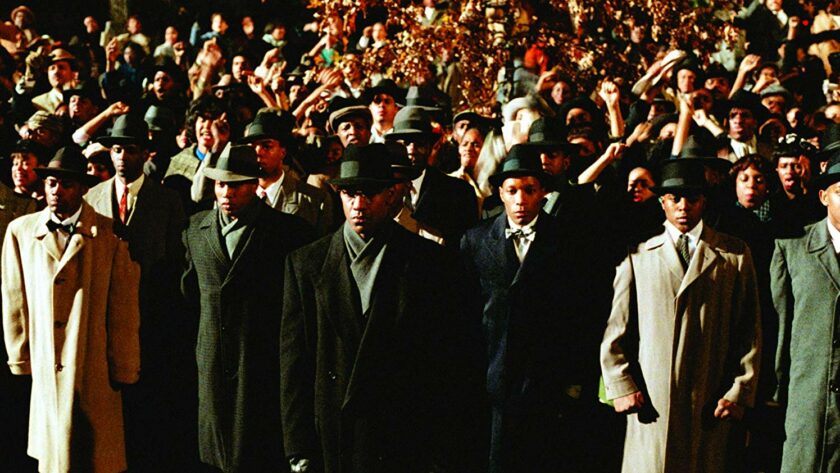Featured image: Malcolm X (1992), dir. Spike Lee
This Black History Month, Sam Hamilton takes a look at the timeline of African-American Cinema, and celebrates its prominent figures and iconic films.
Roots: The Beginnings of African-American Cinema
The topic of ‘the first black filmmaker’ is too vague to ascertain any standing answer. What is more clear is the identity of black cinema’s first titan: Oscar Micheaux. Like many African-Americans of the early 20th century, he emigrated as a young boy from the still-bubbling confederacy of the South to the northern cities; Chicago, in his case. It was there that he wrote his first novel, ‘The Conquest’, which took off to considerable success, and there that the film adaptation of this novel, retitled ‘The Homesteader’ (1919), was written, directed, produced, and released by Micheaux himself. In this filmmaking debut, leading actress Evelyn Preer was acknowledged at the Oscars, if only for a ‘race picture’, and Micheaux’s name was out on the public stage – though it would be titles such as ‘Within Our Gates’ (1920), ‘Body and Soul’ (1925), ‘The House Behind the Cedars’ (1927), and ‘Murder in Harlem’ (1935) that would see him take his place in history.
And while his early work was both hailed and slated as reactionary to Hollywood’s white supremacist outlook, most notably found in ‘Birth of a Nation’, Micheaux’s contribution is undoubtedly much more than that. In boasting a directorial filmography spanning forty-eight films across thirty years, impressing on the world of film the humanity and significance of African-American culture, he marked the inception of a huge, persevering, crucial subset of American cinema and an example of perseverance in the arts that would lead the way for others to follow.

And they did. Spencer Williams’ ‘The Blood of Jesus’ (1941) stands to this day as one of the great filmic assessments of race and religion.Eartha Kitt stole the show in ‘Paris is Always Paris’ (1951) and ‘New Faces’ (1954). Director Michael Audley, who led Sidney Poitier in ‘Mark of the Hawk’ (1957), also starring Kitt, attained a public reputation, with Poitier himself going on to achieve the first black Leading Actor nomination in 1959 for ‘The Defiant Ones’ (1958). It was in the 1950s, perhaps out of political climate, that studios were taking interest in the rise of African-American cinema and the public demand for it. Zanuck and Preminger, a Hollywood power-coupling of producer and director, teamed up once again to to make ‘Carmen Jones’ (1954), giving us the first all-black Hollywood cast in addition to the first black Oscar nomination for Leading Actress in Dorothy Dandridge, just over thirty years after Micheaux’s first film hit the silver screen.
The situation was not yet wholly turned. Rarely were films about African-Americans directed, let alone produced, by individuals who themselves were black. This had been the case with ‘Carmen Jones’ and was the same in Camus’ ‘Black Orpheus’ (1959) even though it was awarded the Grand Prize (now Palme D’Or) of the Cannes Film Festival. Over the coming years, and especially in the sixties, African-American cinema had become adopted by the still predominantly white American production base. What entailed was a wide publicity of black cinema but also an outside perspective in these films that resulted in archetypal characters. In the case of ‘Porgy and Bess’ (1959) this side effect was so severe that, upon its release, it was met with protest in Washington DC.
The situation did, however, improve somewhat in conjunction with the Civil Rights Acts of ’64 and ’65, leading to a surge of African-American authority and autonomy over their own projects. Included amongst this surge was Gordon Parks, whose ‘The Learning Tree’ (1969) mirrored with delicate precision the social angst of the previous decade. And perceptions of the American mythology were altered to great effect by ‘Sergeant Rutledge’ (1960), which finally saw the folkloric American western hero be portrayed by an African-American, while Poitier returned in ‘Lilies of the Field’ (1964) to historically take home the first Leading Actor Oscar. By 1970, African-America was progressing considerably towards the forefront of the world of film and was on the brink of a huge creative cultural event in the “Blaxploitation” era.

Black Dynamite: The Explosion and Effects of “Blaxploitation”
Wendell Franklin, who had ten years before become the first African-American inductee in the Director’s Guild of America, helmed the socially topical cult hit ‘The Bus is Coming’ (1971) before publishing his memoir (aptly titled ‘Wendell Franklin’), in which he recalls the long hard slog of an early career endured before conditions improved for black directors.
It was the improvement of these conditions that saw one of the most bombastic and exciting phases in cinematic history; “Blaxploitation” cinema. In terms of success, it was a lucrative subset of the American film output, but in style it was revolutionary. New definitions for “flashy”, “stylistic” and “cool” are found in the work of directors Melvin Van Peebles, Michael Schultz and (returning with slick mega-hit ‘Shaft’ (1971)) Gordon Parks. They and their colleagues in the genre created cinematic waves that continue to ripple in the often colourful, sometimes brutal, and always cool-to-the-core modern films of John Singleton, Spike Lee, Bill Duke, Antoine Fuqua and the Hughes Brothers, not to mention Quentin Tarantino. Moreover, a beautifully authentic and delightfully deliberate imitation of the Blaxploitation era can be found in Scott Sanders’ recent and underrated ‘Black Dynamite’ (2009).
Yet in cases Blaxploitation cinema was still made via white producers and directors like Larry Cohen, Robert Hartfield-Davis and Jack Hill. However the time of ‘Porgy and Bess’-type simplification and stereotyping seemed to have passed, since these three men made great contributions to the furthering of the genre; Hill was the director of legendary Pam Grier films ‘Coffy’ (1973) and ‘Foxy Brown’ (1974). Taking great inspiration from the latter, Tarantino’s ‘Jackie Brown’ (1997) functioned both as a tribute to and a reboot of the Blaxploitation era, casting Grier herself in the starring role.

In terms of the energetic thrill ride that garnered its widespread audience, Blaxploitation cinema to some extent functioned as a more plot-centric, culturally relevant, and fundamentally American alternative to the exploding industry of Hong Kong martial arts movies that were simultaneously capturing American audiences (at the time the Bruce Lee ‘Dragon’ series and Sonny Chiba’s filmography). Among others, black actor Jim Kelly bridged the gap between the two in the effortless and eclectically cool ‘Enter the Dragon’ (1973).
From the serious, subtextually dark, and challenging ‘Across 110th Street’ (1972) and ‘Killer of Sheep’ (1978), to the more tongue-in-cheek genre films of William Crain in ‘Blacula’ (1972) and ‘Dr. Black, Mr. Hyde’ (1976), Blaxploitation as a wider subset of American cinema ranged from the political to the explosive to the absurd. The constant was radical style, content, and outrageous titles (see Van Peebles’ ‘Sweet Sweetback’s Baadasssss Song’ (1971)).
Yet one of the main features of Blaxploitation that had a profound effect on worldwide cinema was the use of mainstream-oriented music for original film soundtracks. James Brown’s soundtrack for ‘Black Caesar’ (1973) remains a prominent example to this day, with Donny Hathaway’s for ‘Come Back, Charleston Blue’ (1972) and Bobby Womack’s for ‘Across 110th Street’ also being historic examples of this trend-setting tradition, one that has that has carried over into the mainstream film circuit of today.

New Faces: The Modern World
In the mid 1980s, once the dust had settled on Blaxploitation, after Spielberg’s elegiac tribute to the harsh ways of early 20th century Southern life in ‘The Color Purple’ (1985), a young auteur raised in Brooklyn emerged onto the American scene with ‘She’s Gotta Have It’ (1986). Spike Lee followed up his competition-crushing 1986 debut with the inventive ‘Do the Right Thing’ (1989), ‘Mo Better Blues’ (1990), ‘Jungle Fever’ (1991) and ’Malcolm X’ (1992) in what should be regarded as among the finest year-by-year runs of consecutive, energetic, directorial bullseye hits in modern American cinema. What becomes more impressive is that the “little master” went from strength to strength, with a continuation of form in this year’s political powerhouse ‘BlacKkKlansman’ (2018) which took home the Grand Jury Prize at Cannes. In retrospect many including the BFI name Lee as the herald of a “New Black Wave” in 1990s African-American filmmaking. One disciple-piece of that “Wave” could be Cheryl Dunye’s ‘The Watermelon Woman’ (1996), a touchstone in late-century black LGBT cinema.
On the turn of the millennium, it was filmmakers such as Fuqua and Silverton who emerged. The momentum of black cinema at the same time increased and has continued to do so for over fifteen years until now. For in the past two years alone, some of the most talked-about and highly-rated pictures have promoted and centred on the African-American experience, shining examples being ‘Moonlight’ (2016) and ‘Get Out’ (2017). Before them, Steve McQueen lit the film world alight with the huge success and cultural impact of ‘Twelve Years a Slave’ (2013).

Besides these three great successes, there have been many more; the filmographies of Dee Rees (see ‘Mudbound’ (2017)) and Ava DuVernay (‘Middle of Nowhere’ (2012) and ‘Selma’ (2014)), Ryan Coogler (‘Fruitvale Station’ (2013) and ’Creed’ (2014)) , and F. Gary Gary (‘Straight Outta Compton’ (2015)) have together grown wider in audience and stronger and impact. All are presently held alike in the highest regard among the contemporary elite of modern-day Hollywood. The astronomical success of ‘Black Panther’ (2018), its own history deeply rooted in the mid-century Civil Rights movements, demonstrates this tenfold.
To name some names on the explicitly indie African-American would be to mention Andrew Dosunmu and Terence Nance, whose respective ‘Restless City’ (2011) and ‘An Oversimplification of Her Beauty’ (2012) both profited from DuVernay’s founding and leadership of the African-American Film Festival Releasing Movement (AFFRM), as well as her figurative leadership in this new era of black arthouse film (catalysed by Dee Rees’ ‘Pariah’ (2011), quoted as “a precursor to [Jenkins’] Moonlight” (BFI on Rees)). The AFFRM’s value as a promoter of quality cinema can not be denied, nor the value of DuVernay’s efforts understated. Meanwhile, the sometimes-sidesplitting, suddenly-serious, strangely-slapstick-yet-seriously-significant debut by Boots Riley in ‘Sorry to Bother You’ (2018) has by virtue of its own bold genius turned heads towards the prospect of a new and talented writer-director.

The successes of modern African-American cinema, alongside the now-legendary ‘Three Amigos’ (Cuarón, Iñárritu and Del Toro each enjoying great critical and commercial successes), mean that minority cinema has been dominant over the past four years of awards seasons – especially when one considers the likelihood of ‘Roma’ (2018) and ‘If Beale Street Could Talk’ (2018), among others, continuing the trend.
More specifically on the relevant topic of African-American filmmakers, we are left with three names that spring two questions. The names: Spike Lee, Barry Jenkins, and Steve McQueen. The questions: firstly, which of them could be the first African-American winner of the Best Direction Academy Award? And secondly, why does that honour remain a bragging right to be had? I have no doubt that both questions will be the subject of keen discussion as awards season progresses, but the latter is undoubtedly a confusing anomaly, even more so when you step back and take a look at the history.
Black History Month occurs every year from October 1st – October 31st. It focuses and leads a nationwide celebration of Black History, Arts and Culture throughout the UK. Look back at this year’s Black History Month here.




